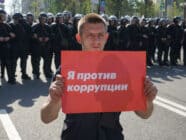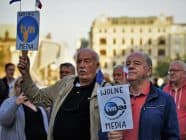Since last November’s EuroMaidan protests many Ukrainian journalists have become social activists, to help fight corruption and foster democratic change. Online and social media continue to be the major platform for their activism. Journalists have been using their popularity, and a wide network of contacts on Facebook and Twitter, to scrutinise the new government, call for reform and urge Ukrainians to make donations to volunteering initiatives.
Independent journalists and popular bloggers were the main driving force behind the EuroMaidan during its earliest stages. Yet the protesters’ victory, preceded by enormous tension and bloodshed, brought about new challenges. Russia’s aggression and war in the eastern region of Ukraine prompted many Maidan activists to switch their activities towards assisting the Ukrainian army, which had been mismanaged and underfunded for years. Some Ukrainian journalists helped to raise money to equip military forces, to supply them with basic ammunition and even food. Others have been targeting internally displaced people from the east who desperately need shelter, supplies and other kinds of assistance.
Oksana Snigur, a journalist at the “Krayina” weekly magazine, started volunteering for the Ukrainian military when her husband and several acquaintances were called up to the army. “My volunteering is small. Relatives of conscripts ask to help them find individual first-aid kits, helmets, or boots, ” Snigur explained. She also takes care of three displaced families. “It is hard to stay totally unconcerned when there’s a war going on in your country,” the journalist said.
EuroMaidan empowered activists and journalists
The EuroMaidan victory, although achieved at a huge cost, empowered many activists and journalists. It has become common for journalists to scrutinise the actions of the new government and president, and pour criticism on them in social media. Many journalists have been advocating various reforms and causes, like the law on “lustration”, which is expected to weed out former president Yanukovych’s appointees and corrupt officials. Furthermore, a record number of Ukrainian journalists ran for parliament in a recent election, with up to a dozen of them elected.
A culture of censorship under President Yanukovych
The level of online activism by journalists can be explained by the lack of media freedom under ex-president Yanukovych. Before the protests a culture of censorship flourished in newsrooms and many journalists turned to social media and other online platforms as a sort of ‘island of free speech’.
Independent online news sources and social networks sites were also crucial to the growth and popularity of the protests. After the EuroMaidan, they have remained highly influential. Two main pages of EuroMaidan activists on Facebook, EuroMaydan and EuroMaidanSOS, have been particularly active in the last twelve months. Both pages provide users with news updates and call for discussion of hot issues related to political developments. The latter page also serves as a sort of hub for various volunteers who are engaged in projects aimed at helping Ukrainian army and war victims.
Digital activism has continued
Many EuroMaidan activists have continued their digital activism efforts, the most recent example being a call for twitter storm under hashtag #OSCEact4Ukraine scheduled for December 4-5, the dates of the 21st Meeting of the Ministerial Council of the OSCE in Basel, Switzerland. The call has been initiated by EuroMaidanPress, a website specializing in translating news about Ukraine into English and distributing them among western media.
Popular online news media, which have been providing extensive and independent news during during the Euromaidan like Ukrayinska Pravda, LB.ua, Espreso.tv, Radio Free Europe/Radio Liberty in Ukraine and others, increased their audience and outreach. Both online news outlets and social media, have appeared to set the agenda for the mainstream media.
One of such online media has enjoyed particular popularity over the last year. Hromadske.tv, a low-budget online TV channel, started broadcasting just as the protests erupted. The station was launched by professional journalists, many of whom had quit their previous jobs on television because of censorship, in pursuit of independent reporting that could challenge oligarch-owned mainstream TV channels.
Public demand for independent reporting has remained high
The broadcaster became one of the main news sources about protests and provided extensive live footage of EuroMaidan. It has managed to keep and even increase its popularity during the last year as public demand for independent reporting has remained very high. The website of Hromadske.tv attracted nearly 80 million visits for the first ten months of their work and their youtube channel has been viewed over 120 million times. The station received several grants from international institutions and collected about $US300,000 in public donations.
The success of Hromadske.tv and other online news media has substantially contributed to media pluralism in Ukraine. It has also revealed a huge public demand for free and independent reporting. However, the media is not yet independent in Ukraine. Coverage of recent parliamentary election has shown that most TV channels and many newspapers remain instruments in the hands of their owners, large tycoons with certain political interests and ties. Observers have also identified numerous cases of paid-for coverage in various media across the country. The lack of editorial independence and an economic crisis that has already hit Ukraine’s media market are likely to challenge media development in the country in the nearest future.
pic credit: Flikr: Sasha Maksymenko
Tags: Online journalism, Press freedom, Social media, Ukrainian Media













































